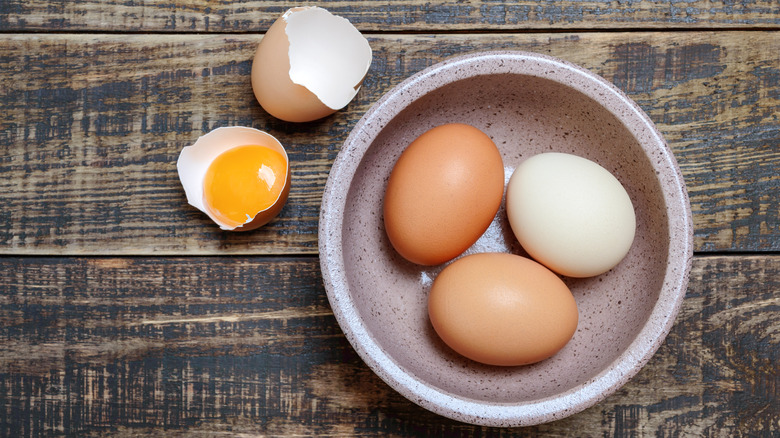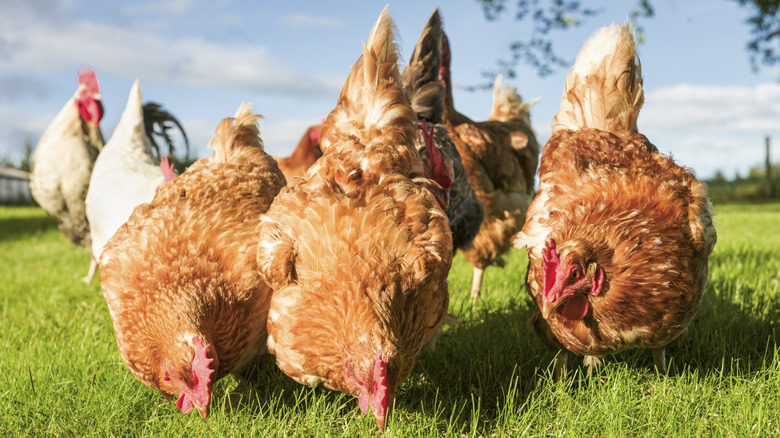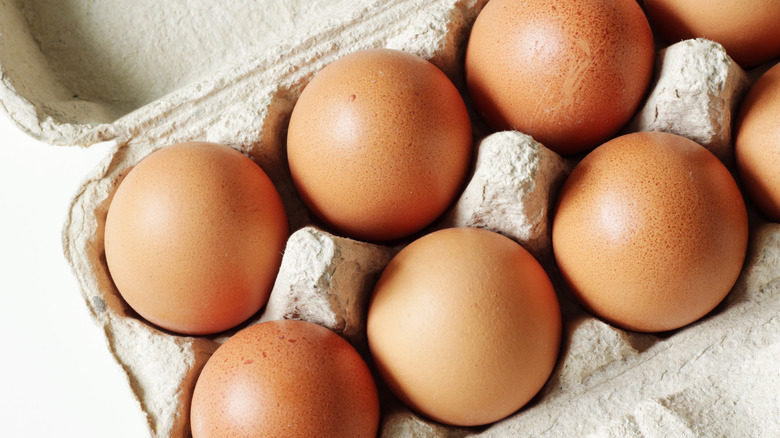The Simple Difference Between Brown And White Eggs
We've done it with sugar, rice, and bread — attributed the color brown with better, more natural, and perhaps healthier. But as with sugar, rice, and bread, that's not necessarily the case when it comes to egg shells. As a result of this faulty perception, brands have seemingly assigned a higher price point and prettier packaging dependent on the egg color as well.
The only real difference between brown eggs and white eggs is the color of their shell. That's it. The shade the egg dons is entirely dependent on the feather and ear color of the hen that lays it, according to Agrilife Today. So that white egg came from a white-coiffed chicken, and the brown one came from a red or brown bird. There is zero difference in the quality of the egg.
The color of the shell also has little-to-no impact on the taste or nutrition of the yolk and white inside. That being said, there are a multitude of factors that can affect both when it comes to what you choose to crack for your omelet.
Different breeds of hens lay different colored eggs
If you've ever purchased eggs straight from the farmer, you may have noticed shell colors other than just brown and white. Shades of light blue, gray, and green may also dot the rows of the carton. The grocery store varieties tend to come in just brown or white based on the hens used for commercial production.
As Agrilife Today explains, all eggs are originally white, but the eggs from hens with white feathers and earlobes will remain so through when they are laid. Eggs from hens with brown or colored feathers and brown earlobes will darken as the egg forms and color is determined inside the chicken. The inside of the shell of both colored eggs is always white, which goes to show how the color of the shell does not permeate or possibly affect the content.
Now, the color of the yolk is a different story. There is a direct correlation between the sunshine shade of the interior and the feed of the hen. As a general rule of thumb, the deeper orange the yolk is, the higher the hen's carotenoid intake. Perhaps the hen is pasture-raised and eats orange pigment plants, or extracts were added to their feed to deepen the color of the yolk. Corn and grain-based diets for the hen will result in a paler, yellow yolk.
Do brown and white eggs taste the same?
Taste is a bit subjective and hard to measure. There may also be a bit of the placebo effect at play as well. Many people claim brown eggs taste better, but have they just fallen under the spell of a well-done marketing ploy?
For the most part, yes. The color of the shell does not affect the taste of the egg whatsoever. However, what the hen eats and the environment in which it resides can affect the taste of the egg, as will its freshness, per Backyard Poultry. The extracts added to color the yolk just may offer up a different taste. Whatever label the carton at the store dons will indicate the feed of the chickens. A pasture-raised bird may lay better-tasting eggs as it has the opportunity to roam around a pasture and eat a varied diet including grubs, worms, grass, and bugs. Some hens may also be fed higher quality feed which may produce a tastier egg. Reading the labels will clue you into the diet of the hen subsequent impact it may have on taste. The diet of the hen will also determine the nutritional value of the egg yolk and white inside.
Nutritional differences between the 2 colors
From a nutrition standpoint, the color of the shell has no effect on the sustenance of the egg white and yolk. Both white and brown eggs of the same size have 70 calories and six grams of protein across the board, according to the American Egg Board. The nutritional composition of the inside of an egg is entirely dependent on what the hen is fed, not its color. You are what you eat eats, in that sense.
Fortified or supplemented feed will have an impact on certain nutrient levels of the egg. If the hens' feed is enriched with Omega-3 fatty acids or vitamin D, the eggs will be of higher value in both, per The Incredible Egg. Whether the hens are pasture-raised, free-range, certified organic, or cage-free will have no guaranteed impact on the nutrition content of the egg white and yolk. The only label to look out for is one indicating that their feed was enhanced.
Why brown eggs are more expensive
The higher price tag on that carton of brown eggs is not just marketing at work. It does cost more to produce brown eggs from hens and the sticker price reflects that. The brown or red birds that lay brown eggs are simply bigger than their white-feathered friends, and they eat more. That extra step the bird takes to add color to the egg shell before it is laid requires extra nutrients and energy expenditure for the hen, thus higher costs in feeding them and that higher price point on the carton.
Brown eggs are also more popular, probably due to the perception that they're healthier, so there is reason to believe manufacturers may not shy away from the advantage that misconception offers them in attaching a price. All in all, the price on the carton is not indicative of the quality, freshness, nutritional value, or any other special features of the eggs lined up inside.




